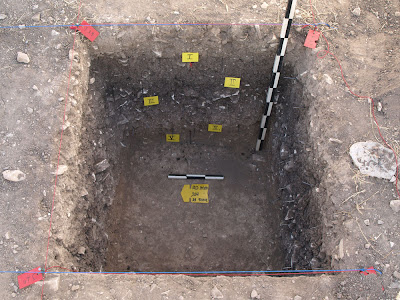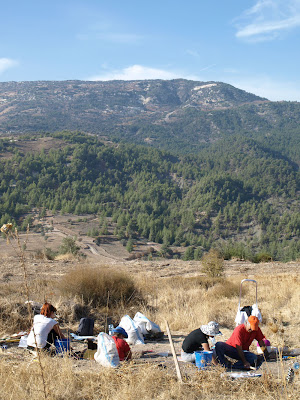The Ministry of Communications and Works, Department of Antiquities, announces the completion of a short season of archaeological investigation conducted by the Department of History and Archaeology of the Aristotle University of Thessaloniki (AUT) at the pre-Neolithic site of Vretsia-Roudias in the Troodos mountains (Pafos District). The project is carried out under the direction of Prof. Nikolaos Efstratiou.
 |
| Excavation trench with stratigraphy [Credit: Republic of Cyprus Department of Antiquities] |
The short field season at this impressively situated Pleistocene terrace of the Xeros River took place at the end of November 2011 and the work was conducted by a small group comprised of undergraduate and postgraduate students of the AUT and of Cypriot archaeologists and special scientists.
The main aims of this year’s investigations were: to further investigate the excavated area, to continue the removal of the site’s fill, at least in the area under investigation, to study the site’s stratigraphy, to further reveal the so-called ‘stone-paved’ area that was identified in 2010 and finally to conduct geoarchaeological research at the site.
The excavation this year produced a different and clearer picture due to the discovery of architectural features such as the so-called ‘stone-paved’ area on the surface of which were found stone tools such as grinders, pounders, cores indicating tool production, burnt pebbles etc but also many other tools which all point towards the existence of a ‘structure’. The other important piece of evidence is that this structure was found to be ‘sealed’ by a black burnt layer, a result of intense burning. Of course this feature’s use remains unclear.
 |
| General view of Rhoudias site [Credit: Republic of Cyprus Department of Antiquities] |
Perhaps the most impressive result of this year’s investigation was the total depth which was reached: over 1, 20 m of archaeological layers were excavated revealing an impressive stratigraphical sequence. This sequence allows for the finds to be easily associated with clearly defined layers, contributing towards the better understanding of Cyprus’ typological and technological sequences related to the beginning of the Holocene, to which the site belongs to (the Epi-Paleolithic period and the early Neolithic (10.000 – 6.000 B.C.). In addition, the site’s deep stratigraphy may be suggesting the existence of even earlier phases of the island’s prehistory. In this sense, the site of Roudias seems to be developing into one characterized by an interesting dynamic.
Amongst the archaeological finds this year are substantial quantities of stone tools of varying sizes, confirming the theory that the site was regularly visited and perhaps seasonally inhabited by groups of hunters and gatherers throughout Cyprus’ early prehistory, from the 10th millennium B.C until the mid 7th millennium B.C.
The third excavation period at the upland site of Roudias confirms the excavators’ initial assessment concerning the role of Cyprus’ mountainous hinterland areas during the yet unknown to us developments of the end of the Pleistocene and beginnings of the Holocene period on the island.
Once more the research team the Aristotle University of Thessaloniki wishes to thank the Cyprus Department of Forests for its invaluable support of the work on the Troodos mountains.
Source: The
Archaeology News Network
No hay comentarios:
Publicar un comentario